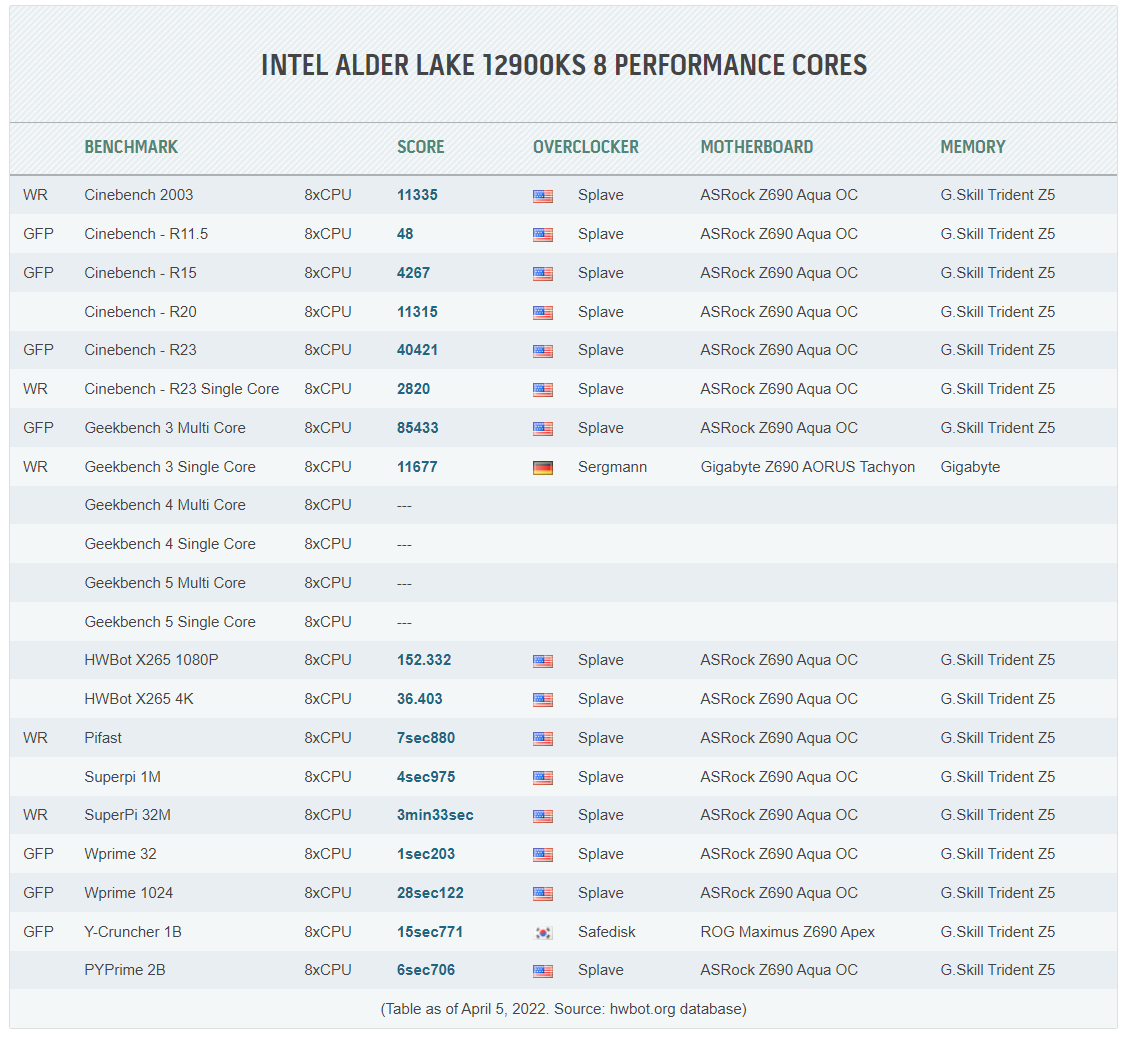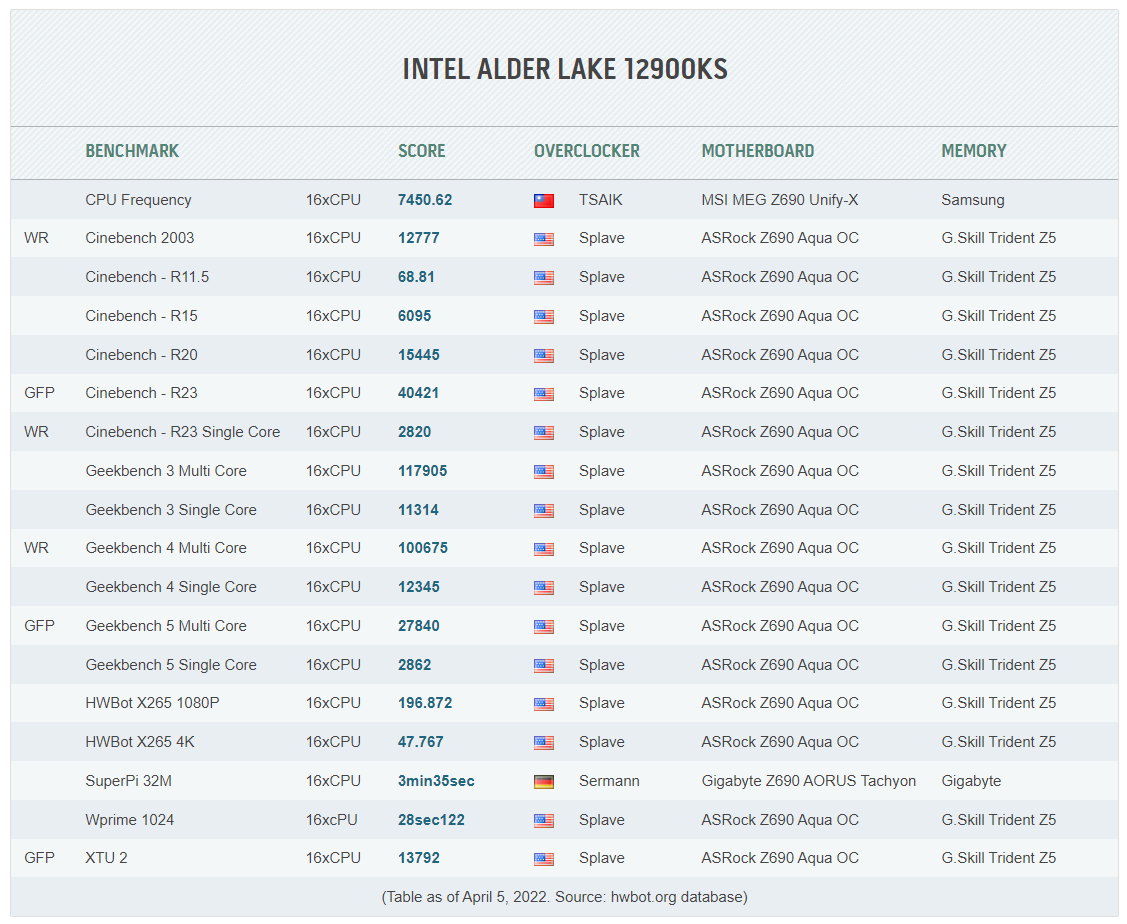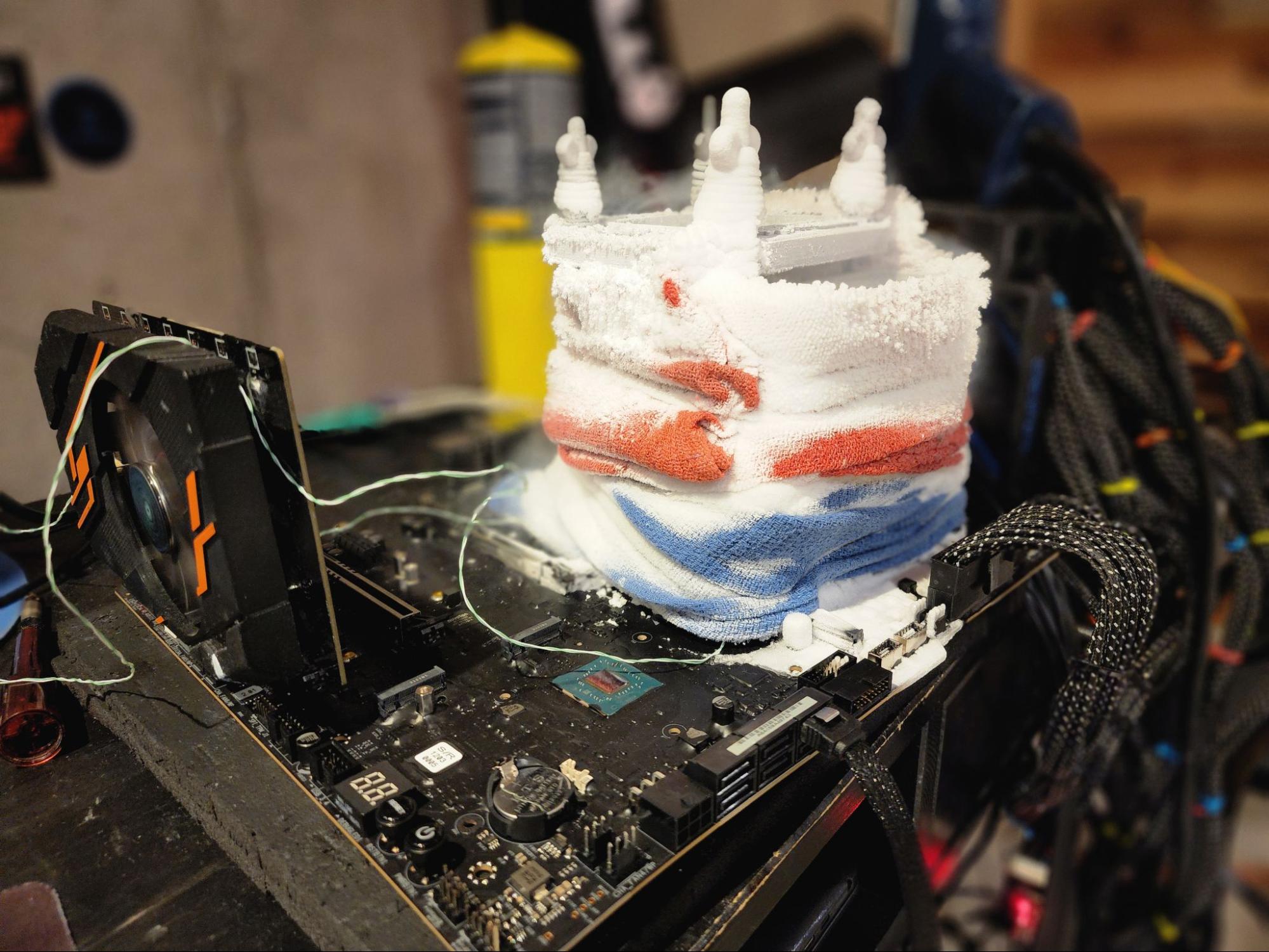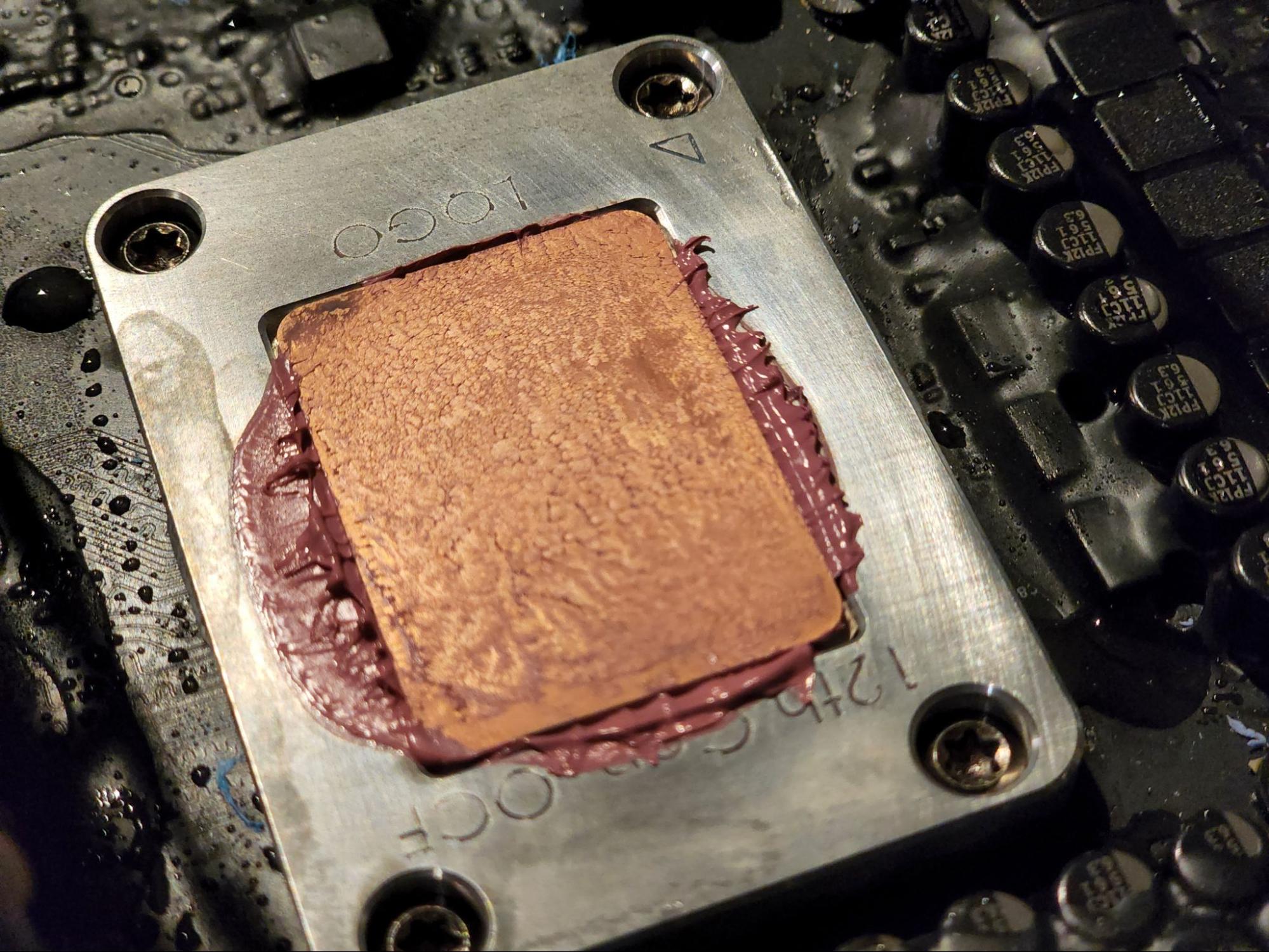Core i9-12900KS World Record: How I Hit 7.8 GHz on 8 Cores
Intel has finally dropped the Core i9-12900KS, its flagship mainstream CPU. So I took a tray full of these chips for a spin, breaking eight world records in six hours, courtesy of 70 liters of liquid nitrogen. I even pushed the 12900KS up to 7.8 GHz on eight cores, breaking the OC record.
One of the best CPUs for gaming, the original Core i9-12900K can hit a boost speed of 5.2-GHz on two P-Cores and goes for a beefy $589 price. The 12900KS brings the rated maximum speed up to 5.5-GHz while adding another $150 to the MSRP. Of course, all of that is achieved without doing any overclocking so I needed to find out what happens when you try to push Intel’s new top-tier chip to its limits.
In a climate where people are paying over retail MSRP for used parts, people are obviously willing to pay more for the top-tier kit. And, make no mistake; the Intel Core i9-12900KS is the leather trim, heated steering wheel, 20-inch wheel trim level of the 12th-Gen Alder Lake series, so you’re paying a premium but getting a premium product.
Is the Core i9-12900KS ‘just’ a machine-binned 12900K? Yes, and in my opinion, it doesn't need to be anything else. Let me show you what a good chunk of them can do on standard water cooling and follow that up with multiple world records and gold trophies with liquid nitrogen cooling, no big deal.
I was lucky enough to get my hands on a full tray of 14 retail Core i9-12900KS CPUs to test and bin before launch. While 14 is a rather small sample size, it can give us an idea about the potential this series has. I do a couple of Cinebench R20 runs with watercooling to quickly test the chip quality. The listed frequencies are on all cores, all the time, with no power-saving shenanigan features activated. Full boost.
The worst chip can still run at 5.3 GHz on liquid cooling, which I would have considered an above-average 12900K/KF. 14 out of 14 pass 5.3 GHz, 13 out of 14 pass 5.4 GHz, and 3 out of 14 can pass 5.5 GHz. I performed these tests with the standard chip hold-down, not the Der8aur OC frame that boosts cooling performance, so there is plenty of potential headroom left.
This frequency bump is absurd to me. On the one hand, I'm a little jaded — these could have been Core i9-12900K CPUs for less money. On the other hand, the cost of one of these KS chips, which pretty much guarantees better overclockability, is less than what I would have lost if I bought two Core i9-12900K CPUs and sold the worst performer for a slight loss. In other words, I would take the KS deal any day.
Get Tom's Hardware's best news and in-depth reviews, straight to your inbox.
Ambient cooling results are "cool," but they aren't nearly as competitive as those we get with full-out extreme overclocking, where nothing matters except first place. Nevertheless, it's always interesting to see the silicon quality when the temperature limits are nearly completely removed. (Can someone pay for my liquid helium?) This is where the KS really shines.
I used an ASRock motherboard for my test system, as I always do. The ASRock Z690 Aqua OC, to be exact, with 2 DIMMs only. For memory, I used the G.Skill Trident Z5 Splave Edition (hey, that’s me!) DDR5 Hynix memory. Paste, it's Kryonaut Extreme. With these parts, how can I fail?
With LN2 cooling, I achieved 7.8 GHz with the Core i9-12900KS in CPU-z with all eight P-cores enabled, while the previous peak with the 12900K maxed out at 7.6 GHz.
In Cinebench R20, I was able to run nearly 7.1 GHz on all threads. For perspective, the 12900K’s previous record was 6.9 GHz!
Here is a list of all the records that fell on the 12900KS release day. It was truly a fun experience with no headaches. I actually managed to complete that entire list in one six-hour-long session with only 70L of liquid nitrogen. That is how dominating this chip is.
- Cinebench 2003 (16xCPU) World Record Achieved: 12777 CB.
- Cinebench – R23 (16xCPU) Global 1st Place Achieved: 40421 CB.
- Cinebench – R23 Single-Core (16xCPU) World Record Achieved: 2820 CB.
- Geekbench 4 Multi-Core (16xCPU) World Record Achieved: 100675 points.
- Geekbench 5 Multi-Core (16xCPU) Global 1st Place Achieved: 27840 points.
- XTU 2 (16xCPU) Global 1st Place Achieved: 13792 marks.
- Cinebench 2003 (8xCPU) World Record Achieved: 11355 CB.
- Cinebench – R11.5 (8xCPU) Global 1st Place Achieved: 48 CB.
- Cinebench – R15 (8xCPU) Global 1st Place Achieved: 4267 CB.
- Cinebench – R23 (8xCPU) Global 1st Place Achieved: 40421 CB.
- Geekbench 3 Multi-Core (8xCPU) Global 1st Place Achieved: 85433 points.
- PiFast (8xCPU) World Record Achieved: 7sec 880ms.
- SuperPi 32M (8xCPU) World Record Achieved: 3min 33sec 356ms.
- Wprime 32 (8xCPU) Global 1st Place Achieved: 1sec 283ms
- Wprime 1024 (8xCPU) Global 1st Place Achieved: 28sec 122ms


You may notice a couple of blank spaces in these score lists. This is because these benchmarks are heavily dependent on AVX, and believe it or not, Intel fused off AVX512 instructions completely on the Core i9-12900KS, its flagship processor.
I find this to be a strange move for a couple of reasons: One, you are paying more for this chip, and it lacks a feature (albeit not an officially supported one). Two, no one is really going to want to disable E-cores just so they can have AVX512 enabled, unless they are pretty much just a bencher. It would have been much easier to market AVX512 support on the KS as an officially-supported feature, making the $200-ish extra price tag hurt a little less. You would be getting more for the money besides clock speed.
So, would I buy the Core i9-12900KS? You bet I would, but I'm a performance freak. If you want the top-performing eight-core CPU and enjoy overclocking, look no further. I just hope you can find one in stock.

A world-champion competitive overclocker who frequently tops the charts at HWBot, a site which tracks speed records, Allen will do just about anything to push a CPU to its limits. He shares his insights into the latest processors with Tom’s Hardware readers from a hardcore, push-it-to-the-limit overclocker’s perspective.
-
waltc3 Totally useless and worthless--what a waste of time...;) Never have liked this sort of thing--doesn't matter who makes the CPU "tested."Reply -
jkflipflop98 Replywaltc3 said:Totally useless and worthless--what a waste of time...;) Never have liked this sort of thing--doesn't matter who makes the CPU "tested."
So was typing this comment onto a userboard on the internet. Yet here we are. -
JeffreyP55 Reply
I remember in the 90's when experts swore up and down that a CPU could never exceed 1GHz. Trace cross talk and component failure they said...Admin said:I took a tray full of Intel Core i9-12900KS chips for a spin, breaking eight world records in six hours, courtesy of 70 liters of liquid nitrogen. I even pushed it up to 7.8 GHz on eight cores, breaking the OC record.
Core i9-12900KS World Record: How I Hit 7.8 GHz on 8 Cores : Read more -
JeffreyP55 ReplyJeffreyP55 said:I remember in the 90's when experts swore up and down that a CPU could never exceed 1GHz. Trace cross talk and component failure they said... My 1st OC was my Amiga 500 M68000 and some i8088. Crystal oscillators were the only way. Performance improvements for turtles. -
escksu 70L of liquid nitrogen!! The amount of energy needed to create that amount of LN2 is many times more than the system.Reply -
Alvar "Miles" Udell Ironically getting closer to the 10ghz CPUs that Intel promised us a couple of decades ago.Reply -
watzupken “That is how dominating this chip is.”Reply
The chip is ”dominating” in every aspect, not just in performance. This is going to heat an entire house and waste a lot of fuel when fuel is in short supply due to dumb sanctions here and there. -
edzieba Reply
Liquifying 70L of LN2 takes ~ 80MJ (accounting for process efficiency), or ~22KWhr. If we make a wild estimate of a 1KW total system power (not unreasonable, overclocks are not efficient to start with and when you start pumping in high voltages it gets worse) that's ~ 22 hours of testing, tweaking, and benchmarking to break even. Not outside the realms of possibility.escksu said:70L of liquid nitrogen!! The amount of energy needed to create that amount of LN2 is many times more than the system.



